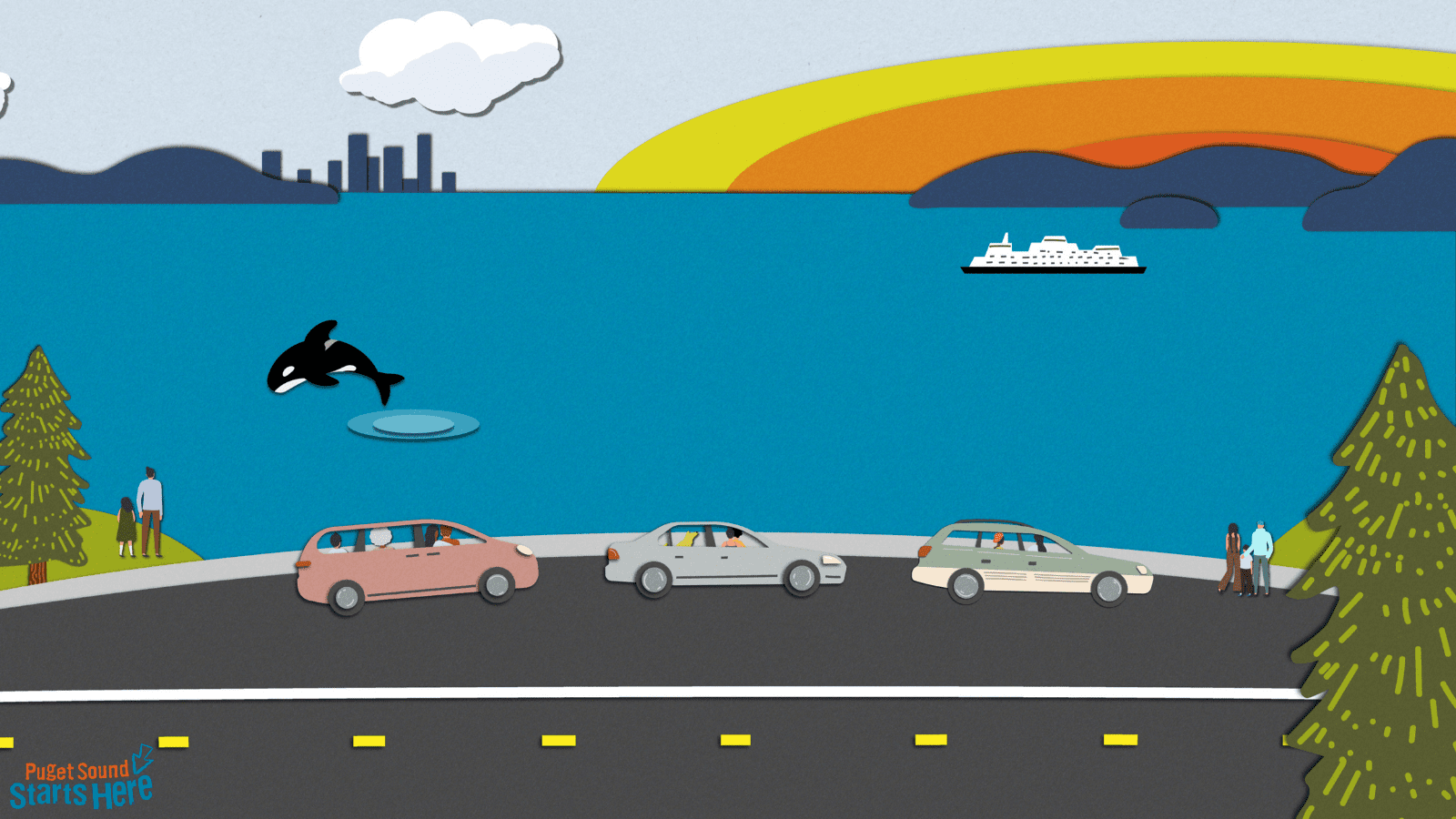
Across Puget Sound, cities and counties are coming together this September to celebrate Puget Sound Starts Here Month. Puget Sound is our economic powerhouse, provides endless recreational opportunities, and is home to incredible, iconic and irreplaceable animals. It’s also in trouble.
We say “Puget Sound Starts Here” because every single day, pollutants from our neighborhoods flow through storm drains to nearby creeks, streams and lakes, which flow into Puget Sound. We rely on clean water for our wellbeing and so do salmon, orcas and other wildlife that live in our shared habitat.
What we do here has an impact on our local waterways and, eventually, on Puget Sound. Join us this month in helping to raise awareness and committing to at least one action that will protect our water quality. By making small changes to our daily activities, we can keep this pollution out of our Puget Sound.
September 2021 campaign focuses on vehicle-related contaminants
Pollution from car tires that flows into our waterways is extremely poisonous to Coho salmon. Research shows that the newly discovered toxic chemical associated with tires (6PPD-quinone) is the reason large numbers of salmon are dying in Northwest creeks before they have a chance to spawn. That’s why this year’s Puget Sound Starts Here Month campaign is focused on vehicle-related pollutants.
With three small changes to how we drive and take care of our cars, we can keep pollution out of our creeks, lakes, rivers and Puget Sound. When it rains, pollution from cars wash into storm drains, and then straight into local streams, lakes, rivers, and Puget Sound. Pollutants like oil, car wash soaps and chemicals, and bits of tire dust are bad for water quality and harm people and wildlife, like salmon and orcas, that depend on clean water to survive.
Car Washing
When you wash your car, the rinse water contains harmful pollutants like oil, grease, heavy metals and soaps. If you wash your car on the street or in your driveway, the pollutants run on the street and into the storm drain, and then flow untreated into our local creeks, lakes, rivers and Puget Sound. In most communities it’s actually illegal to let that soapy water enter a storm drain. Here are two things you can do instead:
- Take your car to a commercial car wash. Commercial car washes are required to treat their dirty wash water.
- If using a commercial car wash isn’t an option, wash your car in a grassy area. The grass and soil will soak up the wash water, preventing it from running down the street into a storm drain.
Don’t Drip and Drive
Even a small oil leak can have a big impact on your car and our creeks, lakes, rivers, and Puget Sound. Every drop on your driveway means a shorter lifespan for your car. Plus, oil and other petroleum products are toxic to people, wildlife, and plants. Take these steps to maintain the health of your vehicle and the environment:
- Check your vehicle for leaks regularly and get them fixed promptly. Learn how to diagnose or fix a leak.
- Always dispose of used motor oil properly by bringing it to your local auto shop for recycling. Call or visit 1-800-RECYCLE to find a location near you.
- Use ground cloths or drip pans if you find a leak or are doing engine work. Clean up spills immediately.
Tire Maintenance
Car tires have many chemicals that help protect them from damage. As we drive, the tires wear down, leaving tiny bits of tire behind on our roads. The chemicals in the tire bits are toxic to fish. When it rains, the runoff picks up the tire bits and carries them down storm drains and into our waterways.
Scientists recently discovered that an ingredient in tires called 6PPD-Q, used to preserve tire rubber, reacts with ozone in the air, transforming it into a new chemical that’s highly toxic to Coho salmon.
Taking care of your tires is the best thing drivers can do to reduce wear and prevent tire pollution. Bonus: proper tire maintenance will extend the life of your tires and save you money.
- Keep tires properly inflated so that they will wear down more slowly. Check your tire pressure once per month, either with your own pressure gauge or at a gas station air pump. You can find the recommended tire pressure in your owner’s manual, stamped on the tire itself, or on a sticker inside the driver’s side door
- Get your tire alignment checked and rotate tires according to the manufacturer’s instructions. Proper alignment and regular rotation prevent uneven wear on your tires, reducing the amount of tire particles that wear off as you drive.
